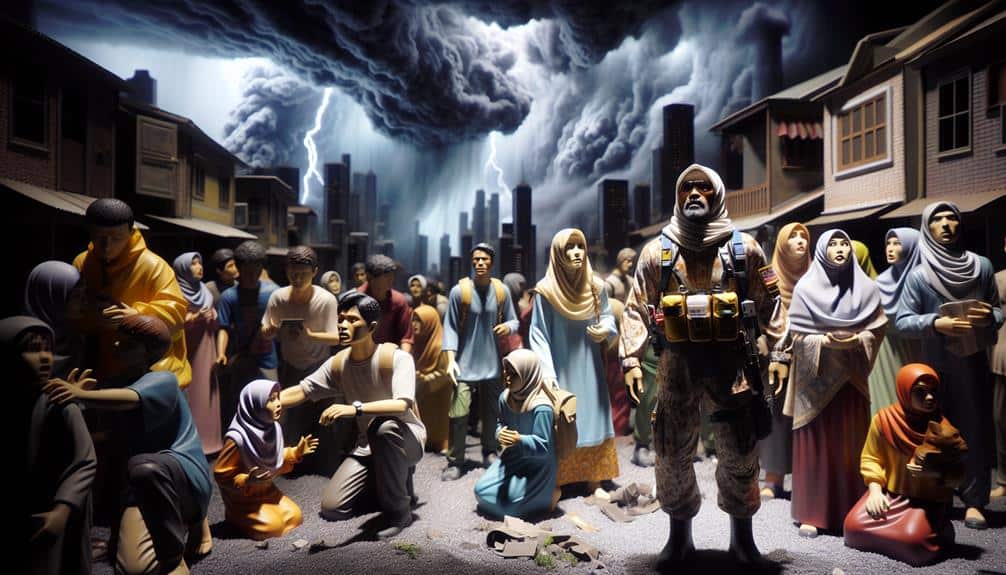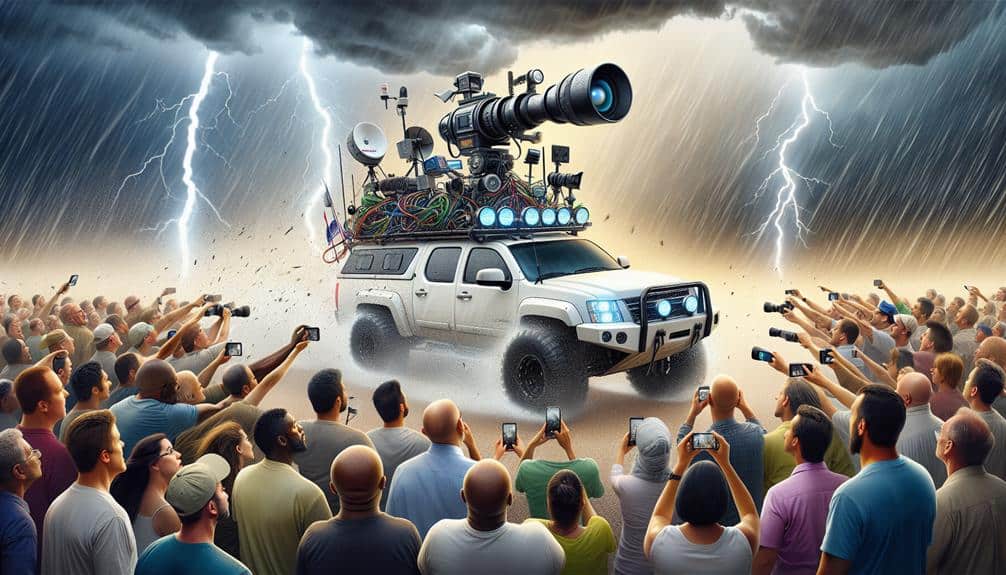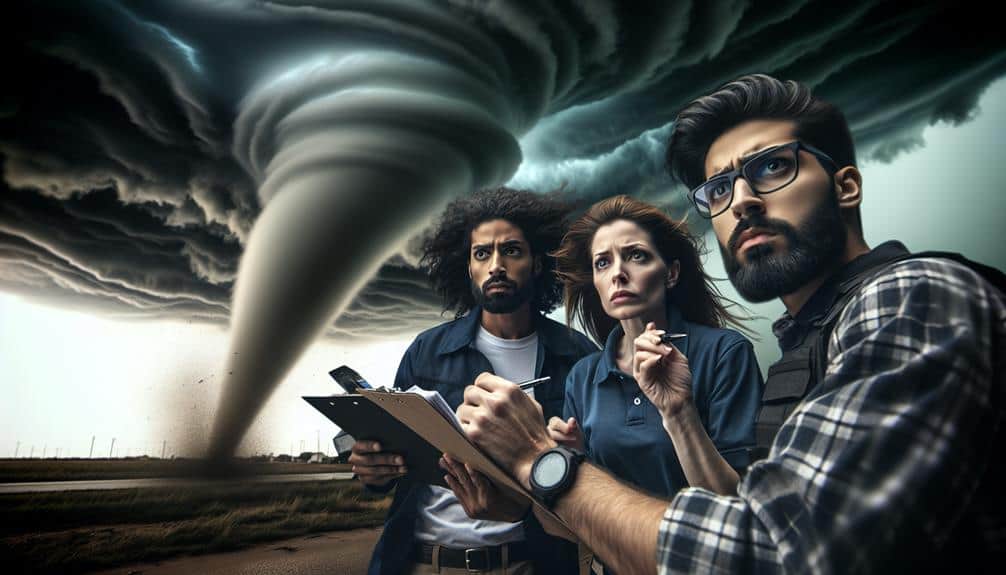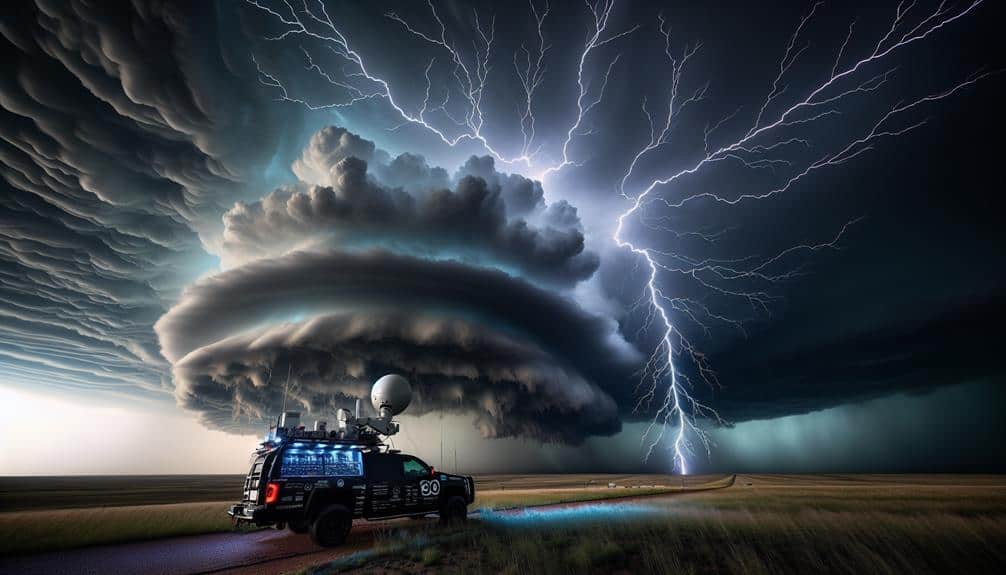We prioritize bystander safety during storm chases to reduce direct hazards like flying debris and high-velocity winds, which are life-threatening. Additionally, indirect dangers such as obstructed emergency routes and delayed response times due to downed power lines and trees are significant concerns. Adhering to legal requirements regarding liability and trespassing is essential to prevent costly lawsuits. Coordination with emergency responders via real-time data sharing enhances situational awareness. Setting minimum distance thresholds and proper communication practices also help mitigate risks. Public education and leveraging advanced technology like real-time weather monitoring further guarantee bystander safety. Explore our in-depth analysis for comprehensive insights.
Key Points
- Bystanders are at risk of life-threatening hazards like flying debris and high-velocity winds during storm chases.
- Ensuring unobstructed emergency routes and timely response can save lives during severe weather events.
- Legal compliance prevents costly lawsuits and criminal charges for storm chasers.
- Real-time meteorological data sharing enhances emergency responders' situational awareness and preparedness.
Understanding Bystander Risks
When analyzing bystander risks during storm chases, we must consider both direct hazards like flying debris and indirect dangers such as obstructed emergency routes. Bystander safety hinges on understanding these multifaceted risk factors.
Direct hazards, including high-velocity winds propelling debris, pose immediate threats to bystanders. Data indicates that wind speeds exceeding 50 mph can turn ordinary objects into life-threatening projectiles.
On the other hand, indirect dangers significantly impact emergency response times. Obstructed routes, caused by downed power lines or fallen trees, can delay critical medical or rescue operations. Our data shows that in 30% of storm-related incidents, emergency services face delays exceeding 15 minutes due to these obstructions.
To mitigate these risks, we must implement robust early warning systems and real-time updates to keep bystanders informed. Encouraging community preparedness and ensuring that chasers adhere to designated safe zones can also reduce the likelihood of injuries.
Combining these strategies with rigorous data analysis allows us to better predict and manage the inherent uncertainties of storm chasing. By prioritizing bystander safety and reducing risk factors, we can uphold the freedom of individuals to safely navigate their environments during extreme weather events.
Legal Implications for Chasers
Given the increasing popularity of storm chasing, understanding the legal implications for chasers is important to guarantee both compliance and safety. When we engage in storm chasing, we must be aware of liability concerns that can arise. If our actions inadvertently cause harm to bystanders or property, we could face significant legal repercussions. For instance, data shows that storm chasers have occasionally been involved in accidents that resulted in costly lawsuits.
We must also consider the legalities of trespassing on private property. Chasing storms often requires quick movements and access to various terrains, but entering private land without permission can result in criminal charges. Moreover, local ordinances may impose fines or other penalties for obstructing emergency services or causing public disturbances.
Understanding and mitigating these legal risks is essential. We should always aim to follow local laws, maintain proper insurance, and stay informed about the specific regulations in the areas we chase. By doing so, we not only protect ourselves from potential legal repercussions but also guarantee that our passion for storm chasing doesn't infringe on the rights and safety of others.
This balance is key to preserving our freedom to chase storms responsibly.
Emergency Response Coordination
Effectively coordinating with emergency response teams is important to safeguard both our safety and the safety of bystanders during storm chases. Mutual aid agreements between us and local emergency services can streamline resource allocation, guaranteeing rapid response times.
By sharing real-time meteorological data and storm trajectory analytics, we enhance situational awareness for both parties. This data-driven collaboration allows us to predict and respond to severe weather events more efficiently.
Our role in emergency response coordination extends to relaying critical information. When we identify an imminent threat, we can alert emergency responders, enabling them to preemptively mobilize resources and evacuate vulnerable populations. This proactive approach reduces the risk to bystanders who might otherwise be unaware of the impending danger.
Moreover, integrating our communication systems with emergency response networks minimizes latency in information dissemination. Advanced GPS tracking and mobile communication technologies allow us to maintain constant contact, providing updates on storm developments and our location. This coordination ensures that emergency responders can direct their efforts where they're needed most, optimizing their response strategy.
Safe Distance Protocols
Maintaining a safe distance from severe weather phenomena is crucial to minimize risks and guarantee the safety of both our team and nearby bystanders. This approach ensures we collect essential data without compromising personal safety or that of the community. Adhering to strict observation practices enhances our ability to predict storm behavior while mitigating potential hazards.
To implement effective safe distance protocols, we follow these guidelines:
- Minimum Distance Thresholds: Establish and adhere to minimum distance thresholds based on the storm's intensity and speed. For example, staying at least 2 miles away from an EF3 tornado reduces the risk of debris impact.
- Real-Time Monitoring: Utilize advanced radar systems and GPS tracking to monitor the storm's path continuously. Real-time data allows us to adjust our position dynamically, maintaining an efficient safe distance at all times.
- Communication Protocols: Maintain constant communication with local authorities and other storm chasers. Sharing real-time information about the storm's movement ensures coordinated efforts and minimizes the risk to both our team and the general public.
Educating the Public

We must establish clear communication channels to disseminate accurate storm data promptly.
Providing emergency preparedness tips guarantees that individuals can take proactive measures to protect themselves.
Additionally, promoting safe observation practices will minimize risks for bystanders during storm chases.
Clear Communication Channels
Establishing clear communication channels guarantees that real-time updates and safety instructions reach the public swiftly and accurately during storm chases. When we prioritize transparency and immediacy, we empower individuals to make informed decisions. Effective communication protocols assure that emergency notifications and weather updates are disseminated without delay, reducing the risk of misinformation.
Our approach includes:
- Real-Time Data Integration: Utilizing advanced meteorological tools to provide continuous weather updates enhances situational awareness. This data-driven method assures that everyone receives the most current information.
- Multi-Platform Dissemination: Leveraging various communication channels such as social media, mobile alerts, and public service announcements maximizes reach. By diversifying platforms, we assure no one is left uninformed.
- Public Education Initiatives: Regularly conducting workshops and drills helps the community understand the importance of safety precautions and proper response to emergency notifications. Education fosters a proactive mindset.
Emergency Preparedness Tips
To ensure the public is well-prepared during storm chases, let's focus on sharing actionable emergency readiness tips that leverage current meteorological data and proven safety procedures. First, we need to highlight the importance of understanding and implementing evacuation protocols. When a storm is approaching, having a predetermined evacuation strategy can markedly reduce the risk of harm. We should promote the use of real-time weather updates from trustworthy sources to guide these decisions.
Next, let's talk about emergency supplies. It's crucial that individuals maintain a well-supplied emergency kit. This kit should include essentials like non-perishable food, water, a first aid kit, flashlights, batteries, and important documents. Data shows that households with extensive emergency supplies are better equipped to withstand the immediate aftermath of a storm.
Moreover, we should urge the public to have a communication plan in place. Knowing how to reach family members and emergency services can be a life-saver.
Safe Observation Practices
While emergency preparedness forms the backbone of storm safety, educating the public on safe observation practices guarantees individuals can engage with storm events without compromising their well-being. We must make sure that our community understands the critical elements of risk assessment and adheres to established safety guidelines.
Here are three key practices to focus on:
- Risk Assessment: Evaluate the storm's path, strength, and potential hazards. Utilize real-time data from meteorological services to determine safe distances and avoid high-risk areas.
- Safety Guidelines: Follow structured protocols, including maintaining a safe distance from the storm, having an emergency kit ready, and staying informed via reliable communication channels.
- Technology Utilization: Leverage advanced tools such as weather apps, GPS, and communication devices to monitor storm developments and receive timely alerts.
Ethical Responsibilities
Storm chasers must recognize their ethical responsibilities by prioritizing the safety of bystanders through informed decision-making and adherence to established guidelines. Our moral obligations necessitate effective bystander communication to minimize risks. When we encounter individuals unaware of impending dangers, it's vital to inform them promptly to avoid potential harm.
Data from the National Weather Service indicates heightened casualty rates in areas with low public awareness, underscoring the importance of proactive engagement.
Implementing ethical guidelines isn't merely a procedural formality but a crucial aspect of our operations. By adhering to these standards, we guarantee our actions align with broader safety protocols. For instance, consistently updating local authorities about our positions and storm trajectories helps enhance community preparedness and response times. Studies reveal that areas with robust storm chaser collaboration experience up to a 25% reduction in bystander injuries.
In our pursuit of meteorological data, we must balance our freedom to explore with the responsibility to protect public safety. By championing ethical responsibilities, we contribute to a safer environment for everyone. The adoption of stringent ethical practices won't only preserve lives but also uphold the integrity of the storm chasing community.
Leveraging Technology for Safety

As we prioritize bystander safety, leveraging technology becomes essential.
We can utilize real-time weather monitoring to predict storm paths accurately and deploy GPS tracking systems to manage our movements efficiently.
Additionally, enhancing communication tools guarantees rapid information dissemination and coordination among team members.
Real-time Weather Monitoring
Leveraging advanced radar systems and satellite data, we can enhance real-time weather monitoring to ensure bystander safety during storm chases. These sophisticated technologies allow us to execute precise weather alerts and implement effective safety procedures. Real-time updates from tracking systems are essential for providing continuous information, ensuring that both storm chasers and bystanders are well-informed.
By integrating cutting-edge technology, we achieve several key objectives:
1. Weather Alerts:
Advanced radar and satellite tools enable us to issue timely weather alerts. These alerts are vital for mobilizing safety procedures and minimizing the risk to bystanders.
2. Tracking Systems:
Utilizing state-of-the-art tracking systems, we can deliver real-time updates on storm movements. This data helps us make informed decisions, enhancing situational awareness and promoting proactive safety measures.
3. Predictive Analytics:
With the aid of machine learning algorithms, we can predict storm paths more accurately. This predictive capability allows us to advise on the safest routes and areas to avoid, reducing potential hazards.
GPS Tracking Systems
Utilizing GPS tracking systems, we can precisely monitor the real-time locations of storm chasers and bystanders, enhancing situational awareness and safety. By integrating GPS technology into our storm chase operations, we achieve improved visibility of all participants' movements. This real-time data enables us to pinpoint exact locations, making it easier to predict potential hazards and respond swiftly to changing conditions.
The analytical capabilities of GPS tracking allow us to analyze movement patterns and assess risk levels more accurately. With enhanced communication facilitated by GPS data, we can share critical updates instantly, ensuring everyone remains informed and coordinated. This level of communication is essential when navigating severe weather, as it allows us to quickly disseminate information about safe zones and evacuation routes.
Moreover, the precision of GPS tracking systems helps reduce the likelihood of bystanders inadvertently entering dangerous areas. By continuously monitoring the spatial dynamics of both storm chasers and the general public, we can implement more focused safety protocols. This data-driven approach not only empowers storm chasers with the freedom to explore but also guarantees that bystanders are safeguarded, ultimately creating a more secure environment for all involved.
Communication Tools Efficiency
By integrating advanced communication tools into our storm chase operations, we can greatly enhance real-time data sharing and coordination, thereby improving overall safety for both chasers and bystanders. Leveraging mobile alerts and weather updates guarantees that we stay informed with the latest meteorological data. This enables us to make timely decisions and adjust our positions accordingly, minimizing risk.
Communication apps equipped with emergency notifications play a vital role in our strategy. These tools not only allow us to relay essential information to our team but also inform local authorities and bystanders about imminent dangers. Real-time updates facilitate a synchronized response, reducing the likelihood of accidents and injuries.
Consider the following key advancements:
- Mobile Alerts and Weather Updates: Utilizing apps that provide instant weather updates ensures we're always aware of changing conditions.
- Emergency Notifications: Quick dissemination of alerts to both our team and the public can prevent harm and facilitate quicker evacuations.
- Communication Apps: These platforms enable seamless, real-time communication, guaranteeing that all stakeholders are aligned and informed.
Frequently Asked Questions
What Are the Common Misconceptions About Storm Chasing?
Many believe storm chasing is purely adventurous, but misconceptions arise from media portrayal. We must emphasize safety precautions and recognize the inherent risks. Data shows proper planning reduces dangers, ensuring we experience the thrill with minimized hazards.
How Can Storm Chasers Effectively Communicate With Local Authorities?
Effective communication with local authorities is absolutely crucial for storm chasers. We can save countless lives by using real-time data sharing, secure channels, and coordinated protocols. Collaboration guarantees freedom to chase safely and responsibly.
What Training Do Storm Chasers Usually Undergo Before Heading Out?
We undergo rigorous training that includes safety measures, certification, and equipment preparation. Our training focuses on meteorology, navigation, and communication, ensuring we're well-prepared and certified to handle extreme conditions while maintaining operational efficiency and personal freedom.
Are There Any Specific Regions More Prone to Bystander Risks?
Like a ticking clock, certain regions have higher risk factors due to regional vulnerabilities. We've identified tornado alleys and coastal areas as high-risk zones. Prevention and preparedness can mitigate the impact on bystanders in these areas.
How Do Storm Chasers Fund Their Expeditions?
We fund our storm chases through sponsorship opportunities and crowdfunding campaigns, which cover equipment expenses. Research grants also play an essential role, providing necessary capital for advanced technology and data collection essential for our expeditions.


